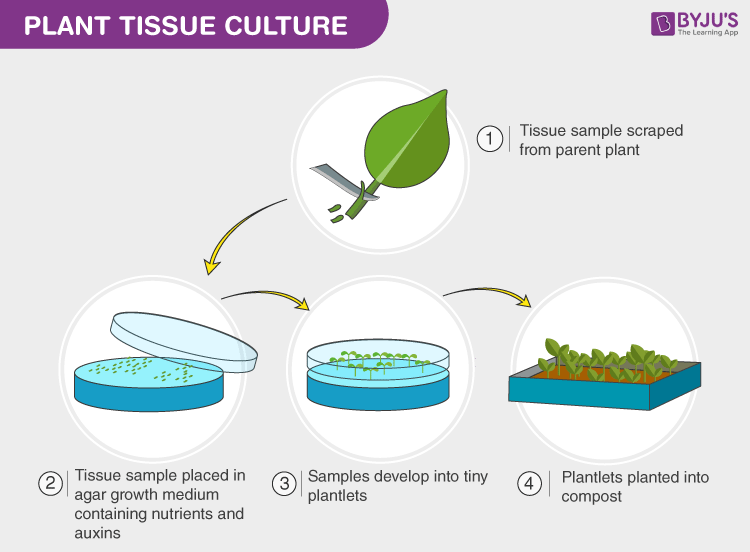
Plant tissue culture was a new addition to the methods of plant breeding that developed around the 1950s. Since the conventional breeding techniques could not fulfil the required demand of crops, tissue culture came around as a grand leap in breeding practices. It makes use of parts of a plant to generate multiple copies of the plant in a very short duration. The technique exploits the property of totipotency of plant cell which means that any cell from any part of the plant can be used to generate a whole new plant.

Types of Plant tissue culture
- Seed Culture
- Embryo Culture
- Callus Culture
- Organ Culture
- Protoplast Culture
- Anther Culture
Procedure of Plant tissue culture
The part(s) of the plant used for culturing is known as explants. The explants are cultured in-vitro on a nutrient medium that caters to fulfil its nutritional requirements. The nutrient medium must provide the following:-
- Macronutrients – This includes elements like nitrogen (N), phosphorus (P), potassium (K), calcium (Ca), sulfur (S) which is required for proper growth and morphogenesis.
- Micronutrients – Elements like iron (Fe), manganese (Mn), zinc (Zn) etc., which are also crucial to the growth of tissues.
- Carbon or Energy source – This is one of the most crucial ingredients of the nutrient media. Sucrose is the most widely used carbon source among other carbohydrates that serve to provide C, H, and O.
- Vitamins, amino acids, and other inorganic salts.
Apart from these, the culture media also serves as a medium for supplying phytohormones or plant growth regulators to the issues which bring about their morphogenesis as per requirement. The tissues of the explants first lose their specificity to form a hard brown lump known as callus. The callus then splits to develop a plant organ or a whole new plant depending upon the quantity and composition of phytohormones supplied. The entire process requires strict aseptic conditions to be maintained at all times as a single contamination can ruin an entire batch of plants.
Uses of Plant tissue culture
Tissue culture is used to develop thousands of genetically identical plants from one single parent plant known as somaclones, and this process is known as micropropagation. The method offers an advantage over other methods as it can be used to develop disease free plants from disease-rode plants by using their meristems (apical and axillary) as explants.
Since this method produces new plantlets by the score of thousands, it has been used extensively for the production of commercially important plants including food plants like tomato, banana, apple etc. The most notable example of the application of micropropagation was observed in the farming of orchids as it rose exponentially due to the availability of millions of plantlets due to tissue culture methods.
For a more detailed understanding of plant tissue culture techniques, login to BYJU’S.


Comments